本篇内容主要给大家通过实例讲述了javascript读取和写入cookie的相关知识点,有这方面需要的朋友参考下吧。
首先先让我们简单地了解一下cookie.
在我们制作网页的过程中,经常需要把信息从一个页面传递给另一个页面,这时候就需要用到JavaScript中的cookie机制了。简单说来,cookie提供了一种便捷的方式,能够在用户的计算机上保存少量数据并且远程获得它们,从而让网站可以保存一些细节信息,比如用户的习惯设置或是上一次访问网站的时间。cookie本身是一些短小的信息,能够由页面保存在用户的计算机上,然后被其他页面读取。cookie一般都设置为在一定时间后失效。
当然,cookie也有局限之处:浏览器对于能够保存的cookie数量有所限制,通常是几百个或者多一点。一般情况下,每个域名20个cookies是允许的,而每个域最多能保存4KB的cookie.除了大小限制可能导致的问题,也有很多原因会引起硬盘上的cookie消失,比如达到有效期限了,或是用户清理了cookie信息,或是换用了其他浏览器。因此,cookie不适合用来保存重要数据,在编写代码时也要考虑到cookie获取异常的处理方法。
在JavaScript中,使用document对象的cookie属性来储存和获取cookie.通常,document.cookie里的信息是由成对的名称和值组成的字符串,每一对数据的形式是:
立即学习“Java免费学习笔记(深入)”;
1 |
|
下面我们将通过一个简单的例子来展示在JavaScript中如何读取和写入cookie.
首先是createCookie.html,在该页面中会创建一个cookie,完整的代码如下:
1 2 3 4 5 6 7 8 9 10 11 12 13 14 15 16 17 18 19 20 21 |
|
该页面的截图如下:
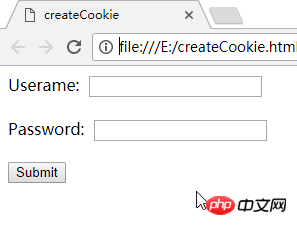
点击submit按钮,就会创建一个cookie,在该cookie中保存了Username和Password信息,并且会跳转到showCookie.html页面。其中,showCookie.html页面的完整代码如下:
1 2 3 4 5 6 7 8 9 10 11 12 13 14 15 16 17 18 19 |
|
页面截图如下:
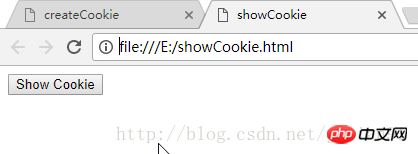
点击show Cookie按钮就会显示cookie里面的信息了。
下面,我们将会在本地和服务器上分别跑这个程序,分别在IE浏览器和Chrome浏览器上运行这个程序,看看cookie的运行情况。
首先我们在本地运行这个程序,我们将上述两个文件都放在E盘中。先在IE浏览器上运行,在createCookie.html页面上输入信息,并点击submit按钮,截图如下:

跳转到showCookie.html页面后,点击show Cookie按钮,页面截图如下:

cookie在本地环境中的IE浏览器中运行正常。
接下来,我们看看在Chrome浏览器中运行情况,首先在Chrome浏览器中打开createCookie.html页面,输入信息,并点击submit按钮,截图如下:
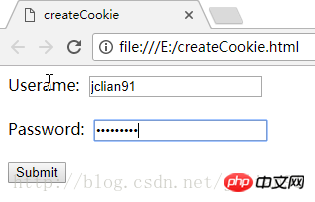
跳转到showCookie.html页面后,点击show Cookie按钮,页面截图如下:
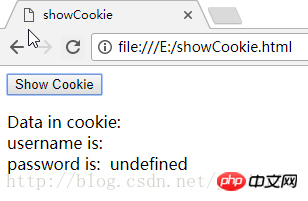
同样的程序,这次cookie在Chrome浏览器中却运行失败了。
接着让我们在服务器中运行这个程序,需要用到xampp,并打开Apache服务器,将上述两个html文件放在xampp安装文件夹下的htdocs文件夹下(具体的操作方法可以参考这篇博客:JavaScript之使用AJAX(适合初学者))。我们现在IE浏览器中运行该程序,在IE浏览器中输入网址:http://localhost/createCookie...:
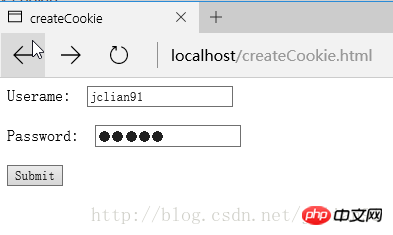
点击Submit按钮,跳转到showCookie.html页面,并点击show Cookie按钮,截图如下:

然后我们在Chrome浏览器中输入网址:http://localhost/createCookie...:
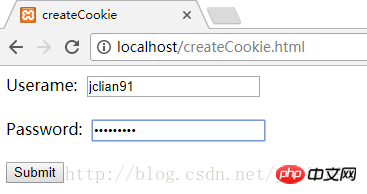
点击Submit按钮,跳转到showCookie.html页面,并点击show Cookie按钮,截图如下:
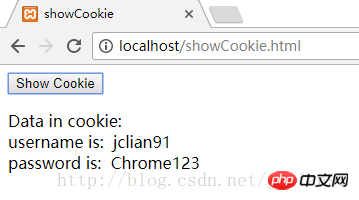
这次在服务器环境下,IE浏览器和Chrome浏览器的cookie都运行正常!
上面是我整理给大家的,希望今后会对大家有帮助。
相关文章:
vue+springboot如何实现单点登录跨域问题(详细教程)
以上就是在JavaScript中如何实现读取和写入cookie的详细内容,更多请关注php中文网其它相关文章!

java怎么学习?java怎么入门?java在哪学?java怎么学才快?不用担心,这里为大家提供了java速学教程(入门到精通),有需要的小伙伴保存下载就能学习啦!

Copyright 2014-2025 https://www.php.cn/ All Rights Reserved | php.cn | 湘ICP备2023035733号